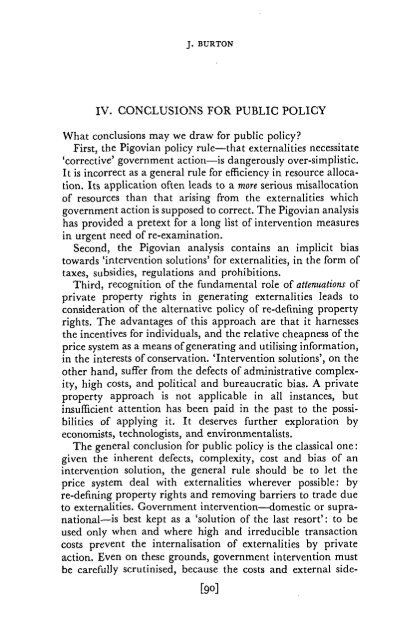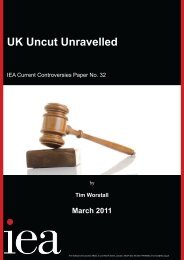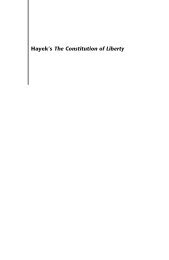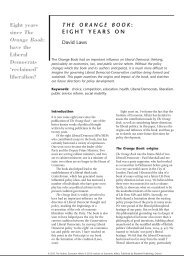THE MYTH OF SOCIAL COST.pdf - Institute of Economic Affairs
THE MYTH OF SOCIAL COST.pdf - Institute of Economic Affairs
THE MYTH OF SOCIAL COST.pdf - Institute of Economic Affairs
You also want an ePaper? Increase the reach of your titles
YUMPU automatically turns print PDFs into web optimized ePapers that Google loves.
J. BURTON<br />
IV. CONCLUSIONS FOR PUBLIC POLICY<br />
What conclusions may we draw for public policy?<br />
First, the Pigovian policy rule—that externalities necessitate<br />
'corrective' government action—is dangerously over-simplistic.<br />
It is incorrect as a general rule for efficiency in resource allocation.<br />
Its application <strong>of</strong>ten leads to a more serious misallocation<br />
<strong>of</strong> resources than that arising from the externalities which<br />
government action is supposed to correct. The Pigovian analysis<br />
has provided a pretext for a long list <strong>of</strong> intervention measures<br />
in urgent need <strong>of</strong> re-examination.<br />
Second, the Pigovian analysis contains an implicit bias<br />
towards 'intervention solutions' for externalities, in the form <strong>of</strong><br />
taxes, subsidies, regulations and prohibitions.<br />
Third, recognition <strong>of</strong> the fundamental role <strong>of</strong> attenuations <strong>of</strong><br />
private property rights in generating externalities leads to<br />
consideration <strong>of</strong> the alternative policy <strong>of</strong> re-defining property<br />
rights. The advantages <strong>of</strong> this approach are that it harnesses<br />
the incentives for individuals, and the relative cheapness <strong>of</strong> the<br />
price system as a means <strong>of</strong> generating and utilising information,<br />
in the interests <strong>of</strong> conservation. 'Intervention solutions', on the<br />
other hand, suffer from the defects <strong>of</strong> administrative complexity,<br />
high costs, and political and bureaucratic bias. A private<br />
property approach is not applicable in all instances, but<br />
insufficient attention has been paid in the past to the possibilities<br />
<strong>of</strong> applying it. It deserves further exploration by<br />
economists, technologists, and environmentalists.<br />
The general conclusion for public policy is the classical one:<br />
given the inherent defects, complexity, cost and bias <strong>of</strong> an<br />
intervention solution, the general rule should be to let the<br />
price system deal with externalities wherever possible: by<br />
re-defining property rights and removing barriers to trade due<br />
to externalities. Government intervention—domestic or supranational—is<br />
best kept as a 'solution <strong>of</strong> the last resort': to be<br />
used only when and where high and irreducible transaction<br />
costs prevent the internalisation <strong>of</strong> externalities by private<br />
action. Even on these grounds, government intervention must<br />
be carefully scrutinised, because the costs and external side-<br />
[90]












